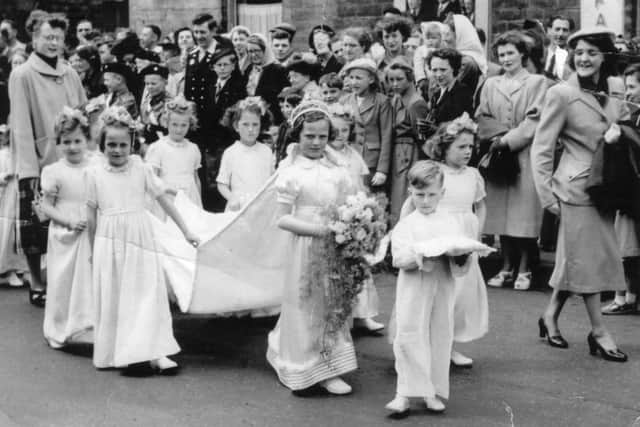Nostalgia with Margaret Watson: The customs of Whitsuntide
and live on Freeview channel 276
Margaret Watson writes: Even if you give it its more commonly known name of “Whitsuntide”, there are still many who won’t know what you’re talking about.
Today, it seems the term “Whitsuntide” has been wiped off the British calendar to be replaced by the words “Bank Holiday”.
Advertisement
Hide AdAdvertisement
Hide AdYet, how many people realise when they’re enjoying this national holiday that it comes to them courtesy of the Christian church, just as Christmas and Easter do.


The word holiday means “holy day”.
But few people today realise the significance of holy days because most of them no longer go to church.
But there are many in Dewsbury who still remember the significance of Whitsuntide and what this festival used to be like in days gone by.
For it was the day when children were given a new outfit of clothes and allowed to go round the neighbourhood showing them off.
Advertisement
Hide AdAdvertisement
Hide AdWe would knock on the doors of neighbours and proudly tell them – “We’ve come to show you our new clothes” – and we’d be given a penny or two for the privilege.
Even the poorest of families would save all year round to make sure their children got a new outfit to wear on Whit Sunday.
Whitsuntide was also the time of year when local churches of all persuasions took to the streets to promote their faith.
In my day the Catholics and Anglicans seemed to have the biggest and best processions, with brass bands leading the way.
Advertisement
Hide AdAdvertisement
Hide AdBut, if you go back to Victorian times, the most impressive processions were those organised by the Free churches – Baptists, Congregationalists, Methodists – who swelled their numbers by combining with each other for their Whit walk.
One such procession in Dewsbury in 1859 had well over 2,500 people taking part, and there were thousands lining the streets to watch them.
Before setting off, this large gathering assembled in the public hall situated at the bottom of Halifax Road, opposite Mark Oldroyd’s mill.
A simple address was given by the Reverend J Shillto, after which the children formed in procession and departed in continuous file to the Market Place where they began singing hymns.
Advertisement
Hide AdAdvertisement
Hide AdThe churches taking part that day included Westtown Primitive Methodists, Ebenezer Congregationalists (now Longcauseway Church), New Wakefield Primitive Methodists, Springfield Congregationalists, Hanging Heaton New Connexions (now Ebenezer Methodists), Chapel Fold Baptists and Salem New Connexions.
After the hymn singing, the New Connexion Sunday Schools went to fields near the Leeds Road cutting where they played a variety of games.
The Springfield scholars retired to their school for refreshments, and the scholars from other churches dispersed to their schools and regaled themselves with the usual fare of tea and buns.
In later years, the processions which attracted the greatest interest were those organised by the local Catholic churches.
Advertisement
Hide AdAdvertisement
Hide AdSt Paulinus Church, Westtown, and St Joseph’s Church, Batley Carr, often held their processions on the same day, Whit Monday, and always at the same time.
They met up at the top of Daisy Hill and proceeded together to the town centre with brass bands playing and banners flying in the breeze.
Every detail of these magnificent processions had been organised by the Sisters of the Cross and Passion who taught at the two church schools mentioned.
These processions were so spectacular that local photographers often took pictures of them which were then made into postcards and sold widely.
Advertisement
Hide AdAdvertisement
Hide AdThe local newspapers also sent journalists to cover them and report what they were like and take photographs.
One journalist who attended one of their processions said it was a scene of unsurpassed beauty, a great witness of the faith which local Catholics held so dear.
He added: “It was a remarkable testimony to the strength and vigour of the Catholic community in Dewsbury.”
These two churches no longer hold processions, and I doubt if there are any other churches in the town who still continue this tradition.
Advertisement
Hide AdAdvertisement
Hide AdPerhaps the Dewsbury Gospel Church still does because this particular church knows all about Whitsuntide and what it represents – The Feast of Pentecost.
St Mary’s Roman Catholic Church, in neighbouring Batley, still keeps one procession going, not at Whitsuntide, but in October, when they hold their annual torchlight procession through the town in honour of the Blessed Virgin Mary.
Thousands are attracted to Batley to watch this spectacular event, including people of all faiths, and it is truly a wonderful sight.
It is sad to think that here in Dewsbury our children, no matter what religion, or even those of no religion at all, may never experience Whitsuntide Walks again.
Advertisement
Hide AdAdvertisement
Hide AdIronically, many now travel to foreign lands and witness similar processions and festivals and come home filled with awe and admiration of what they’ve seen.
They have no idea that such processions were once held in their own town and probably their parents and grandparents took part in them.
Whatever you may think of such festivals, even without their religious significance, they are still a great part of our social history, part of the fabric of this town.
That is the reason I will continue writing about them, perhaps not always for the religious message they contain, but as a testament to our forefathers who built the churches from whence they came.
Happy days.